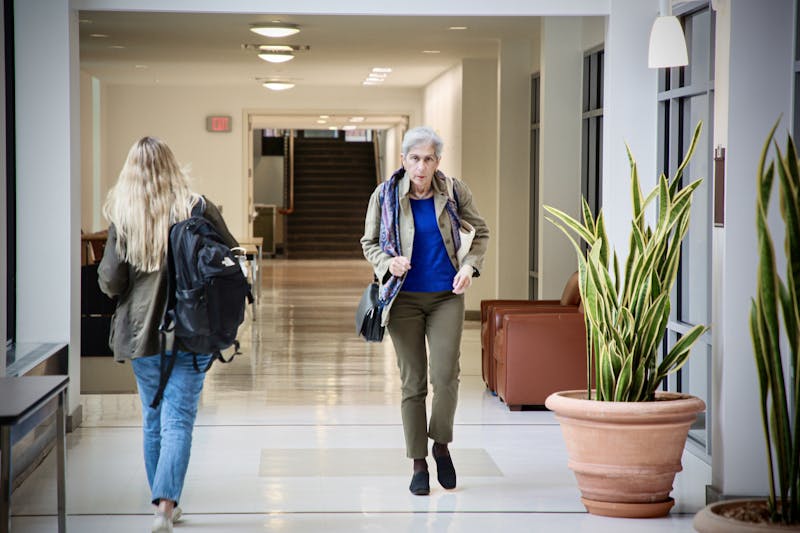From Ian Rosenblum, "Maplewood," Fall '98 From Ian Rosenblum, "Maplewood," Fall '98In an era of widespread change and expansion, Penn officials announced an ambitious plan to construct new dorms and other buildings throughout campus, in effect changing the face of Penn. And then they built the high rises. Fast forward to 1998. The University has announced plans to spend $300 million on a decade-long rehabilitation and construction project designed to reshape the face of campus. Sounds familiar, doesn't it? So what's the difference this time? Almost everything. Thirty years after bulldozing a neighborhood to build Superblock, Penn officials have made strides in involving community members in making decisions, showing that they know they're not defining a future whose impact will be limited to the ivory tower. Without dredging up more history than necessary, it's important to point out that Penn has made some gigantic mistakes in previous attempts to expand the campus -- typically involving demolishing homes to construct new buildings. And though these errors took place decades ago, even top University officials are quick to concede that Philadelphians have long memories. Yet Penn -- despite its No. 6 national ranking and Ivy League status -- can't change the past. Instead, officials have labored to show their commitment to a brighter future for the entire University City community, a future that takes the actual residents into account and listens to their voices. It's often said that the toughest challenge is to translate words into actions. With that it mind, it's important to recognize that the success of any long-term plan -- particularly one as complex and complicated by past conflicts as this one -- is never assured. Still, Penn officials have made some good-faith moves to heal the wounds created by prior mistakes. Small programs like UC Brite, the University City lighting plan that ended earlier this fall, and larger initiatives such as Penn's multi-million-dollar commitment to, and strong support for, the University City District are making real changes in the neighborhoods. And even better, Penn is demonstrating its long-term commitment to the health of the area by funding a new public school at 42nd and Spruce streets, as well as bringing a city magnet school to a plot of land just north of campus -- moves that are aimed at pleasing faculty and the community at large. So what does this have to do with building a new dorm or two? Quite a bit, actually --Ethe transformation of Superblock will have an impact well beyond the borders of campus. Adding 1,000 people to Hamilton Village will significantly alter the shape of student residential patterns. With only 130 beds scheduled to disappear with the demolition of Stouffer College House, 870 people will have to appear from somewhere to fill Penn's newest dorms. And that somewhere, or at least a good part of it, will most likely be off campus. Among community members' top complaints is the ridiculously high density of student-populated areas, and the noise and trash that so many students bring with them. Because few students stay in the same house for more than a year or two, there's virtually no incentive for them to be responsible community members. This is not to say that students won't, or shouldn't, live off campus. Students who want to live in a real house and can be considerate of others without an RA present need to always have that option. In fact, since 46 percent of undergraduates and the vast majority of graduate students currently live off campus, a few more beds in Hamilton Village won't even make a dent. It'll just thin them out a little. More importantly, local landlords will finally have some real competition. One of the hallmarks of the new college houses will be variety, according to officials. So it makes sense that staying on campus -- perhaps in well-designed apartments -- would be more of a viable option for upperclassmen. Though landlords have recently made strides toward improvement, such as by forming a committee to address long-standing tenant concerns, additional living choices will only make the situation better. And with a few of the houses in the blocks west of 40th Street opening up as studens move to the new dorms, it'll be the perfect opportunity for Penn-affiliates and neighborhood families to buy or rent some of University City's rich housing stock. Penn is a step ahead of the game on that one. Since last year, the University has been successfully offering incentives to staff and faculty to either purchase or rehabilitate certain property. In addition, Penn has put its money where its mouth is in urging employees to invest in the community through a generous mortgage program. The apex of University City life 10 years from now should be none other than 40th Street. It's a lot easier for a major entertainment and retail hub to exist when it's next to something other than three examples of all that was wrong with the 1970s: the high rises. First is the possible coloration of the high rises. Assuming that the current "prison-wall concrete" shade is rejected, anything would be better than what we have now. Though a facade is just a facade, changing the image of Penn's dorms will go a long way toward fixing Superblock, at least superficially. But beyond surface improvements, the single most important element of the 10-year plan is the construction of new housing in Superblock. Officials have seemingly learned from the past on this one and are promising smaller-scale college houses based more on the Civic House-style of architecture. If the world-class architects who will eventually be hired do a good enough job combining needed open space with University City's rich and varied architecture in a manner that encourages participation in 40th Street, Penn might just end up with a Hamilton Village after all. But they can't do it alone. Just as Penn officials have vowed to seek student input on construction design, the community must be included before before any plans are set in stone. While Penn has the right -- and responsibility -- to improve its college houses, massive changes to Superblock will no doubt impact the landscape of entire neighborhoods. Only by starting a long-term dialogue can University officials ensure that they won't have another community relations disaster on their hands. Neighborhood leaders must know what is going on and have the opportunity to give feedback -- with the knowledge that their opinions will be taken into serious consideration. Most importantly, both sides must try to bury the hatchet of past grievances. I look forward to returning to Penn on a Homecoming Weekend in the not-too-distant future and seeing a Superblock that isn't an eyesore bordering a vibrant 40th Street, crowded by a wide mix of people. The foundation for such a future will soon be in place; turning the blueprints into reality, though, will require hard work, trust and cooperation. But it'll be worth the effort.
The Daily Pennsylvanian is an independent, student-run newspaper. Please consider making a donation to support the coverage that shapes the University. Your generosity ensures a future of strong journalism at Penn.
DonatePlease note All comments are eligible for publication in The Daily Pennsylvanian.







